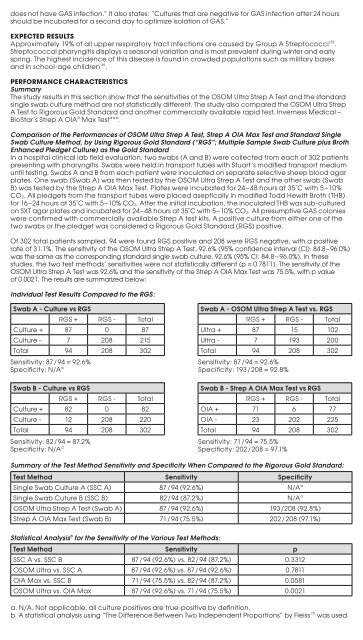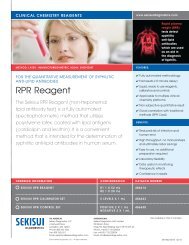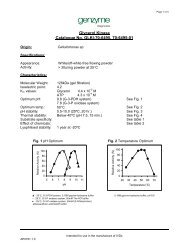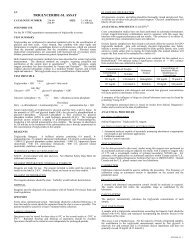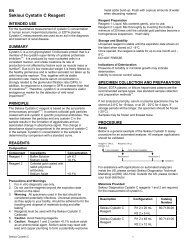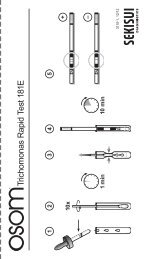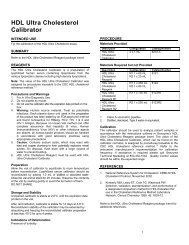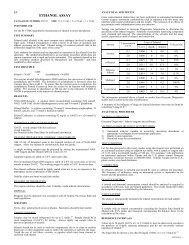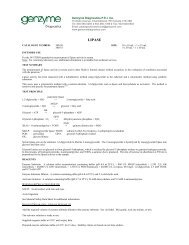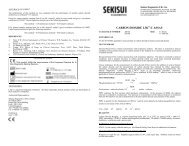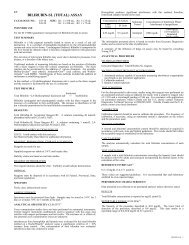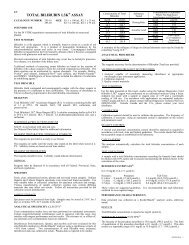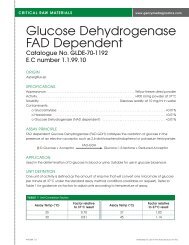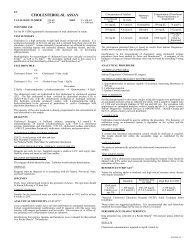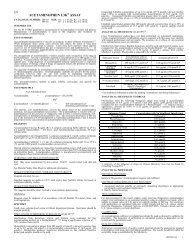OSOM® Ultra Strep A Test - Sekisui Diagnostics
OSOM® Ultra Strep A Test - Sekisui Diagnostics
OSOM® Ultra Strep A Test - Sekisui Diagnostics
Create successful ePaper yourself
Turn your PDF publications into a flip-book with our unique Google optimized e-Paper software.
does not have GAS infection.” It also states: “Cultures that are negative for GAS infection after 24 hoursshould be incubated for a second day to optimize isolation of GAS.”EXPECTED RESULTSApproximately 19% of all upper respiratory tract infections are caused by Group A <strong>Strep</strong>tococci (5) .<strong>Strep</strong>tococcal pharyngitis displays a seasonal variation and is most prevalent during winter and earlyspring. The highest incidence of this disease is found in crowded populations such as military basesand in school-age children (6) .PERFORMANCE CHARACTERISTICSSummaryThe study results in this section show that the sensitivities of the OSOM <strong>Ultra</strong> <strong>Strep</strong> A <strong>Test</strong> and the standardsingle swab culture method are not statistically different. The study also compared the OSOM <strong>Ultra</strong> <strong>Strep</strong>A <strong>Test</strong> to Rigorous Gold Standard and another commercially available rapid test, Inverness Medical –BioStar’s <strong>Strep</strong> A OIA ® Max <strong>Test</strong>***.Comparison of the Performances of OSOM <strong>Ultra</strong> <strong>Strep</strong> A <strong>Test</strong>, <strong>Strep</strong> A OIA Max <strong>Test</strong> and Standard SingleSwab Culture Method, by Using Rigorous Gold Standard (“RGS”; Multiple Sample Swab Culture plus BrothEnhanced Pledget Culture) as the Gold StandardIn a hospital clinical lab field evaluation, two swabs (A and B) were collected from each of 302 patientspresenting with pharyngitis. Swabs were held in transport tubes with Stuart’s modified transport mediumuntil testing. Swabs A and B from each patient were inoculated on separate selective sheep blood agarplates. One swab (Swab A) was then tested by the OSOM <strong>Ultra</strong> <strong>Strep</strong> A <strong>Test</strong> and the other swab (SwabB) was tested by the <strong>Strep</strong> A OIA Max <strong>Test</strong>. Plates were incubated for 24 – 48 hours at 35˚C with 5 – 10%CO2. All pledgets from the transport tubes were placed aseptically in modified Todd Hewitt Broth (THB)for 16 – 24 hours at 35˚C with 5 – 10% CO2. After the initial incubation, the inoculated THB was sub-culturedon SXT agar plates and incubated for 24 – 48 hours at 35˚C with 5 – 10% CO2. All presumptive GAS colonieswere confirmed with commercially available <strong>Strep</strong> A test kits. A positive culture from either one of thetwo swabs or the pledget was considered a Rigorous Gold Standard (RGS) positive.Of 302 total patients sampled, 94 were found RGS positive and 208 were RGS negative, with a positiverate of 31.1%. The sensitivity of the OSOM <strong>Ultra</strong> <strong>Strep</strong> A <strong>Test</strong>, 92.6% (95% confidence interval (CI): 84.8 – 96.0%)was the same as the corresponding standard single swab culture, 92.6% (95% CI: 84.8 – 96.0%). In thesestudies, the two test methods’ sensitivities were not statistically different (p = 0.7811). The sensitivity of theOSOM <strong>Ultra</strong> <strong>Strep</strong> A <strong>Test</strong> was 92.6% and the sensitivity of the <strong>Strep</strong> A OIA Max <strong>Test</strong> was 75.5%, with p valueof 0.0021. The results are summarized below:Individual <strong>Test</strong> Results Compared to the RGS:Swab A - Culture vs RGSRGS + RGS - TotalCulture + 87 0 87Culture - 7 208 215Total 94 208 302Sensitivity: 87 / 94 = 92.6%Specificity: N/A aSwab B - Culture vs RGSRGS + RGS - TotalCulture + 82 0 82Culture - 12 208 220Total 94 208 302Sensitivity: 82 / 94 = 87.2%Specificity: N/A aSwab A - OSOM <strong>Ultra</strong> <strong>Strep</strong> A <strong>Test</strong> vs. RGSRGS + RGS - Total<strong>Ultra</strong> + 87 15 102<strong>Ultra</strong> - 7 193 200Total 94 208 302Sensitivity: 87 / 94 = 92.6%Specificity: 193 / 208 = 92.8%Swab B - <strong>Strep</strong> A OIA Max <strong>Test</strong> vs RGSRGS + RGS - TotalOIA + 71 6 77OIA - 23 202 225Total 94 208 302Sensitivity: 71 / 94 = 75.5%Specificity: 202 / 208 = 97.1%Summary of the <strong>Test</strong> Method Sensitivity and Specificity When Compared to the Rigorous Gold Standard:<strong>Test</strong> Method Sensitivity SpecificitySingle Swab Culture A (SSC A) 87 / 94 (92.6%) N/A aSingle Swab Cuture B (SSC B) 82 / 94 (87.2%) N/A aOSOM <strong>Ultra</strong> <strong>Strep</strong> A <strong>Test</strong> (Swab A) 87 / 94 (92.6%) 193 /208 (92.8%)<strong>Strep</strong> A OIA Max <strong>Test</strong> (Swab B) 71 / 94 (75.5%) 202 / 208 (97.1%)Statistical Analysis b for the Sensitivity of the Various <strong>Test</strong> Methods:<strong>Test</strong> Method Sensitivity pSSC A vs. SSC B 87 / 94 (92.6%) vs. 82 / 94 (87.2%) 0.3312OSOM <strong>Ultra</strong> vs. SSC A 87 / 94 (92.6%) vs. 87 / 94 (92.6%) 0.7811OIA Max vs. SSC B 71 / 94 (75.5%) vs. 82 / 94 (87.2%) 0.0581OSOM <strong>Ultra</strong> vs. OIA Max 87 / 94 (92.6%) vs. 71 / 94 (75.5%) 0.0021a. N/A, Not applicable, all culture positives are true-positive by definition.b. A statistical analysis using “The Difference Between Two Independent Proportions” by Fleiss (7) was used.


